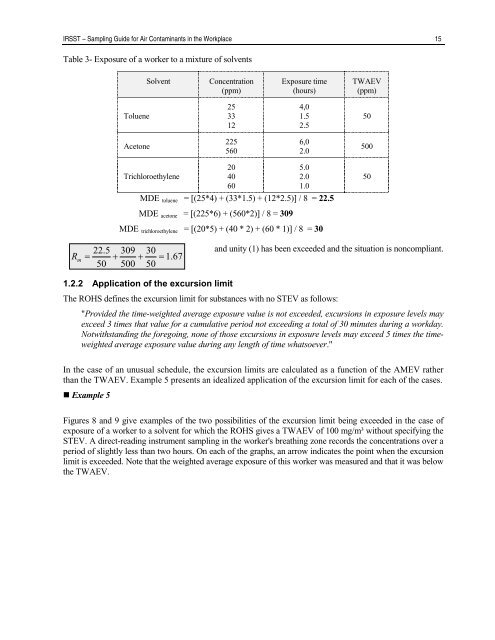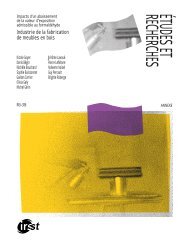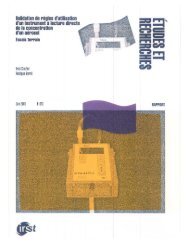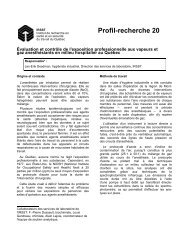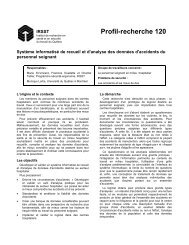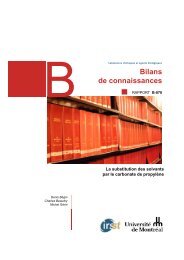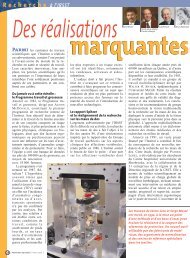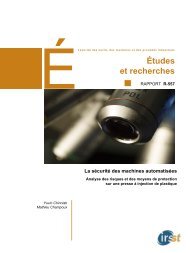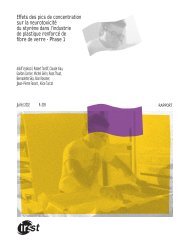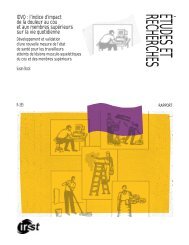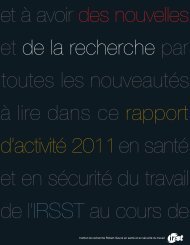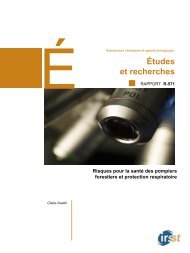Sampling Guide for Air Contaminants in the Workplace - Irsst
Sampling Guide for Air Contaminants in the Workplace - Irsst
Sampling Guide for Air Contaminants in the Workplace - Irsst
You also want an ePaper? Increase the reach of your titles
YUMPU automatically turns print PDFs into web optimized ePapers that Google loves.
IRSST – <strong>Sampl<strong>in</strong>g</strong> <strong>Guide</strong> <strong>for</strong> <strong>Air</strong> <strong>Contam<strong>in</strong>ants</strong> <strong>in</strong> <strong>the</strong> <strong>Workplace</strong> 15<br />
Table 3- Exposure of a worker to a mixture of solvents<br />
Solvent<br />
Concentration<br />
(ppm)<br />
Exposure time<br />
(hours)<br />
TWAEV<br />
(ppm)<br />
Toluene<br />
25<br />
33<br />
12<br />
4,0<br />
1.5<br />
2.5<br />
50<br />
Acetone<br />
225<br />
560<br />
6,0<br />
2.0<br />
500<br />
Trichloroethylene<br />
20<br />
40<br />
60<br />
5.0<br />
2.0<br />
1.0<br />
MDE toluene = [(25*4) + (33*1.5) + (12*2.5)] / 8 = 22.5<br />
50<br />
MDE acetone = [(225*6) + (560*2)] / 8 = 309<br />
MDE trichloroethylene = [(20*5) + (40 * 2) + (60 * 1)] / 8 = 30<br />
R m<br />
=<br />
22.5<br />
50<br />
+<br />
309<br />
500<br />
+<br />
30<br />
= 1.67<br />
50<br />
and unity (1) has been exceeded and <strong>the</strong> situation is noncompliant.<br />
1.2.2 Application of <strong>the</strong> excursion limit<br />
The ROHS def<strong>in</strong>es <strong>the</strong> excursion limit <strong>for</strong> substances with no STEV as follows:<br />
"Provided <strong>the</strong> time-weighted average exposure value is not exceeded, excursions <strong>in</strong> exposure levels may<br />
exceed 3 times that value <strong>for</strong> a cumulative period not exceed<strong>in</strong>g a total of 30 m<strong>in</strong>utes dur<strong>in</strong>g a workday.<br />
Notwithstand<strong>in</strong>g <strong>the</strong> <strong>for</strong>ego<strong>in</strong>g, none of those excursions <strong>in</strong> exposure levels may exceed 5 times <strong>the</strong> timeweighted<br />
average exposure value dur<strong>in</strong>g any length of time whatsoever."<br />
In <strong>the</strong> case of an unusual schedule, <strong>the</strong> excursion limits are calculated as a function of <strong>the</strong> AMEV ra<strong>the</strong>r<br />
than <strong>the</strong> TWAEV. Example 5 presents an idealized application of <strong>the</strong> excursion limit <strong>for</strong> each of <strong>the</strong> cases.<br />
• Example 5<br />
Figures 8 and 9 give examples of <strong>the</strong> two possibilities of <strong>the</strong> excursion limit be<strong>in</strong>g exceeded <strong>in</strong> <strong>the</strong> case of<br />
exposure of a worker to a solvent <strong>for</strong> which <strong>the</strong> ROHS gives a TWAEV of 100 mg/m³ without specify<strong>in</strong>g <strong>the</strong><br />
STEV. A direct-read<strong>in</strong>g <strong>in</strong>strument sampl<strong>in</strong>g <strong>in</strong> <strong>the</strong> worker's breath<strong>in</strong>g zone records <strong>the</strong> concentrations over a<br />
period of slightly less than two hours. On each of <strong>the</strong> graphs, an arrow <strong>in</strong>dicates <strong>the</strong> po<strong>in</strong>t when <strong>the</strong> excursion<br />
limit is exceeded. Note that <strong>the</strong> weighted average exposure of this worker was measured and that it was below<br />
<strong>the</strong> TWAEV.


